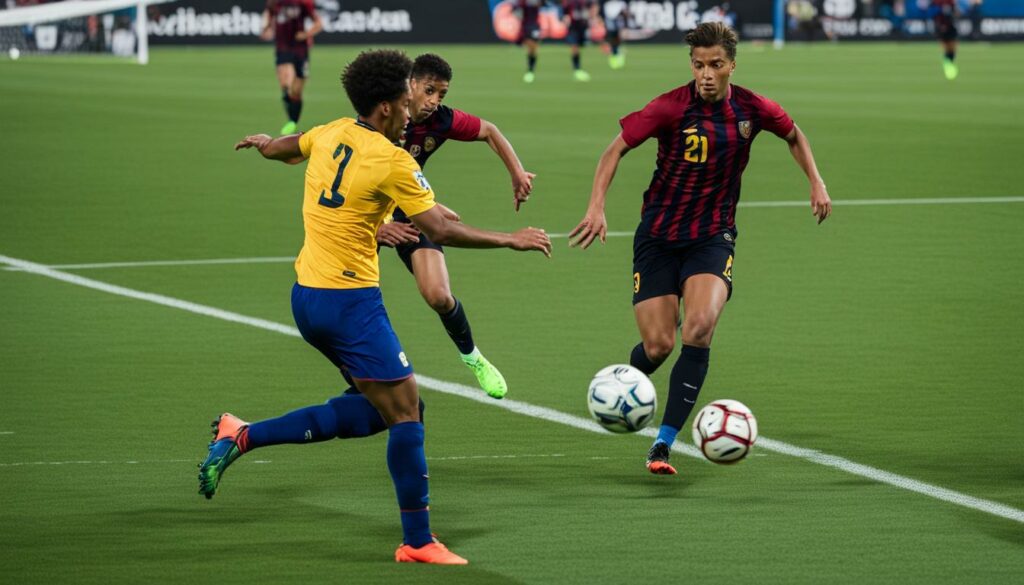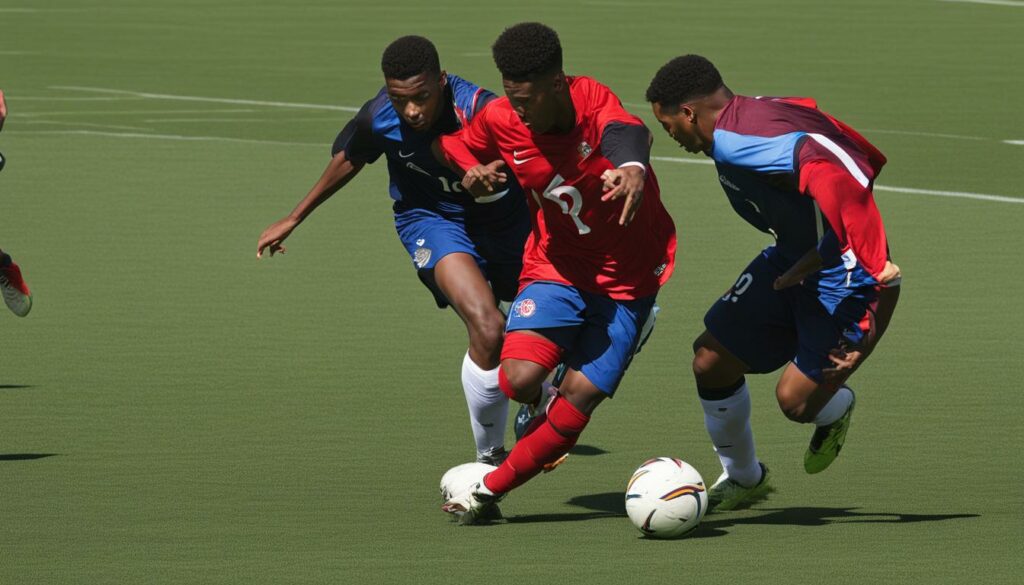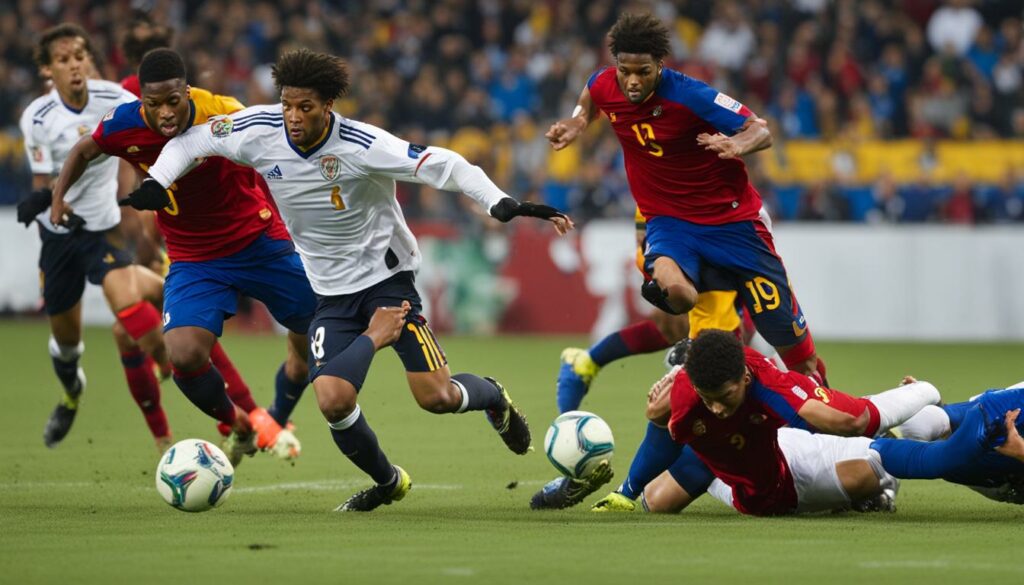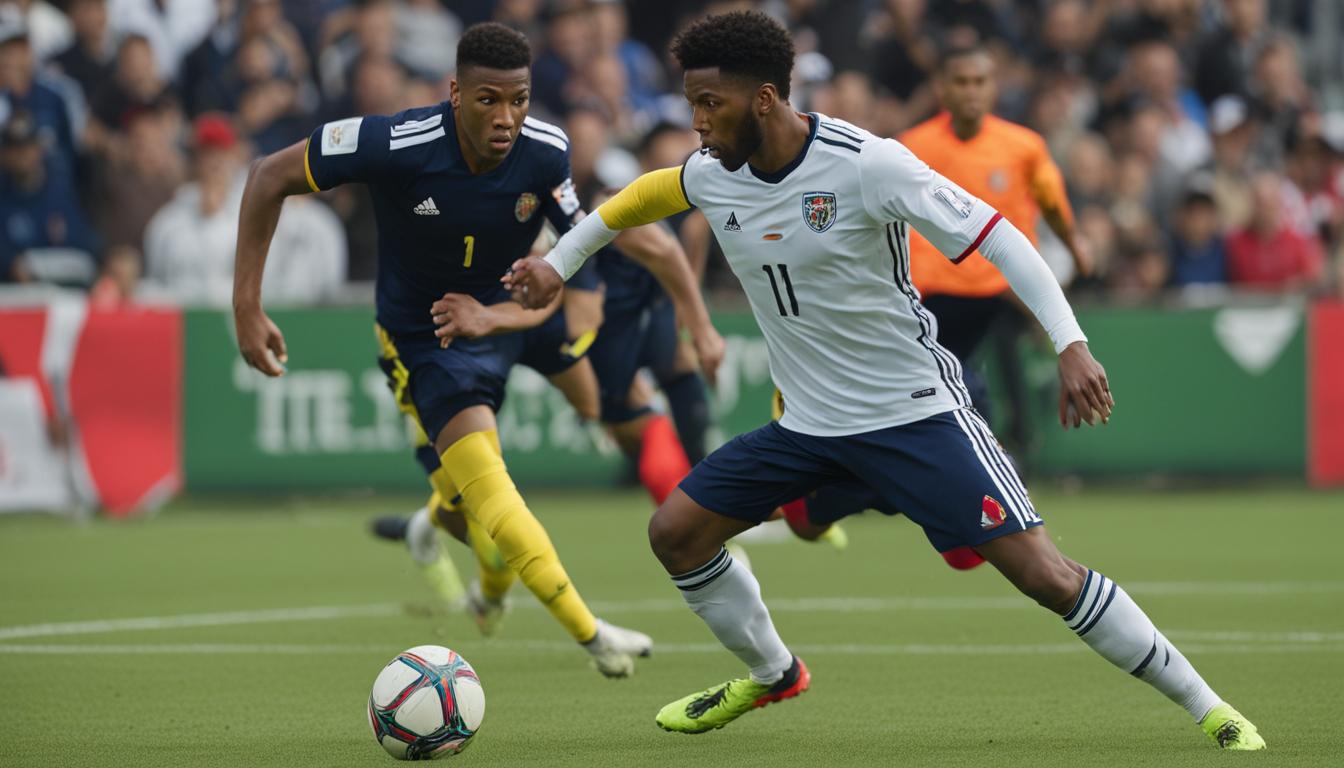The Central Defensive Midfielder (CDM) is a crucial position in
Key Takeaways:
- The Central Defensive Midfielder (CDM) plays a vital role in providing a defensive shield and breaking up opposing attacks.
- The CDM needs to have good passing and vision to connect midfield and defense.
- Positioning, defensive skills, and winning aerial duels are important attributes for a CDM.
- The CDM can be utilized in various formations, depending on the team’s tactics.
- Communication, leadership, and tactical understanding are essential skills for a CDM.
The Central Defensive Midfielder (CDM) Role and Responsibilities
The central defensive midfielder (CDM) plays a pivotal role in any
Defensive midfielder skills are crucial for the CDM role. The player must have excellent tactical awareness, positioning themselves strategically to disrupt the opposition’s play. Physical strength and stamina are essential for winning duels, intercepting passes, and covering defensive gaps. Possessing strong defensive skills, such as tackling and intercepting, enables the CDM to regain possession and neutralize the opponent’s threats.
Aside from defensive duties, the CDM must also contribute to the team’s offensive play. This requires good passing ability and vision to provide a link between the defense and midfield. The CDM’s role is to distribute the ball accurately, find teammates in advantageous positions, and help transition the team from defense to attack.
Responsibilities of a Central Defensive Midfielder:
- Providing a defensive shield in front of the defense
- Breaking up opposition attacks
- Regaining possession through tackling and intercepting
- Protecting the back four and covering defensive gaps
- Initiating and contributing to the team’s counter-attacks
- Linking the defense and midfield with accurate passing
- Displaying leadership, discipline, and communication on and off the pitch

| Key Defensive Midfielder Attributes | Description |
|---|---|
| Tactical Awareness | Ability to read the game, position strategically, and make quick decisions. |
| Physical Strength and Stamina | Strong physical presence to win duels and cover large areas of the pitch. |
| Defensive Skills | Proficient tackling, intercepting, and ability to neutralize opponents. |
| Passing Ability | Accurate and incisive passing to transition the team from defense to attack. |
| Leadership | Guiding and motivating teammates, setting the tone in the midfield. |
| Discipline | Executing responsibilities without losing composure or making unnecessary fouls. |
CDM in Different Formations
The Central Defensive Midfielder (CDM) is a versatile position that can be utilized in various formations in
4-2-3-1 Formation
In the 4-2-3-1 formation, the CDM plays a crucial role in protecting the backline. Positioned behind the attacking midfielders, the CDM acts as a defensive shield, breaking up opposition attacks and intercepting passes. This formation allows the CDM to provide cover for the defenders and offer passing options for the midfielders.
4-3-3 Formation
In the 4-3-3 formation, the CDM sits deeper and helps control the midfield. With two central midfielders alongside, the CDM becomes the link between defense and attack, dictating the team’s tempo. The CDM’s primary role in this formation is to disrupt the opponent’s play, win the ball back, and initiate counter-attacks.
3-5-2 Formation
The 3-5-2 formation utilizes a midfield triangle, with the CDM forming the base. In this formation, the CDM is responsible for protecting the defense and providing passing options. The CDM needs to read the game well, anticipate the opponent’s movements, and maintain a compact structure in midfield.
5-3-2 Formation
In the 5-3-2 formation, the CDM plays a vital role in maintaining defensive solidity. With three center-backs behind, the CDM acts as a shield, providing cover and disrupting the opponent’s attacks. This formation requires the CDM to have excellent positional awareness, tackling ability, and the vision to distribute the ball effectively.
4-1-4-1 Formation
The 4-1-4-1 formation emphasizes defensive solidity and compactness. The CDM in this formation plays a crucial role in breaking up opposition plays and shielding the defense. The CDM needs to be disciplined and positionally aware, covering the gaps left by the midfielders and providing a defensive presence in front of the backline.
Understanding the different formations and the corresponding positioning of the CDM is essential for players and coaches. Each formation offers unique challenges and opportunities for the CDM to showcase their skills and contribute to the team’s success.
| Formation | CDM Positioning | Responsibilities |
|---|---|---|
| 4-2-3-1 | Behind attacking midfielders | Defensive shield, intercept passes, provide passing options |
| 4-3-3 | Sits deeper in midfield | Control midfield, disrupt opponent’s play, initiate counter-attacks |
| 3-5-2 | Forms midfield base | Protect defense, provide passing options, maintain compact structure |
| 5-3-2 | Acts as defensive shield | Provide cover, disrupt opponent’s attacks, distribute the ball effectively |
| 4-1-4-1 | Provides defensive presence | Break up opposition plays, shield the defense, cover midfield gaps |
Strengths of a Good Defensive Midfielder
A successful central defensive midfielder (CDM) possesses a range of strengths that contribute to their effectiveness on the field. These qualities not only make them a formidable presence in the midfield but also crucial for their team’s overall success. Let’s explore some of the key strengths associated with the CDM role.
The Tactical Awareness
CDMs exhibit exceptional tactical awareness, which allows them to read the game and anticipate the opponents’ moves. This skill enables them to position themselves strategically, maintain defensive shape, and intercept passes or win back possession. Their ability to understand and adapt to different game situations is instrumental in neutralizing opposition attacks.
Physical Strength and Stamina
Physicality is a vital aspect of a good CDM’s game. They should possess the strength and stamina to engage in physical battles and consistently cover large areas of the pitch. The CDM’s physical attributes contribute to their ability to win aerial duels, hold off opponents, and maintain a strong defensive presence throughout the game.
Defensive Skills
Defensive proficiency is a hallmark of a top-notch CDM. They excel in tackling, marking opponents, and intercepting passes. Their defensive prowess enables them to break up opposition attacks, disrupt the flow of play, and protect the defense. A skilled CDM can quickly regain possession and provide a solid foundation for their team.
Passing Ability and Vision
While primarily known for their defensive contributions, CDMs also play a crucial role in initiating attacks and distributing the ball. Their passing ability and vision allow them to find their teammates in advantageous positions and launch counter-attacks. Effective passing and strategic decision-making are essential for CDMs to connect the defense with the midfield and contribute to the team’s attacking play.
| Strengths of a Good Defensive Midfielder |
|---|
| Tactical Awareness |
| Physical Strength and Stamina |
| Defensive Skills |
| Passing Ability and Vision |
As illustrated in the table above, a good defensive midfielder possesses a combination of tactical awareness, physical strength and stamina, defensive skills, and passing ability with vision. These strengths enable them to excel in their role, protect the defense, break up opposition attacks, and contribute to the team’s overall gameplay. DCMs play a vital role in maintaining the balance between defense and attack, making them an indispensable asset to any team.
Famous Central Defensive Midfielders
The central defensive midfielder position has seen some extraordinary talents over the years. These players have showcased their exceptional skills, attributes, and leadership qualities, earning them recognition as some of the most famous central defensive midfielders in the history of
One notable name in this list is Joshua Kimmich. Known for his versatility, Kimmich has excelled in the defensive midfielder role for both club and country. His intelligence, passing ability, and tireless work rate have made him a vital asset to Bayern Munich and the German national team.
Sergio Busquets is another name that stands out among defensive midfielders. Playing for FC Barcelona and the Spanish national team, Busquets has demonstrated remarkable vision, positional awareness, and composure on the ball. He has been instrumental in winning numerous titles and is widely regarded as one of the best in his position.
Other exceptional defensive midfielders include Casemiro, Fabinho, N’Golo Kante, Jorginho, and Sandro Tonali, who have all made significant contributions to their respective teams with their defensive prowess, ability to control the midfield, and overall impact on the game.
| Player | Club/ National Team |
|---|---|
| Joshua Kimmich | Bayern Munich, Germany |
| Sergio Busquets | FC Barcelona, Spain |
| Casemiro | Real Madrid, Brazil |
| Fabinho | Liverpool, Brazil |
| N’Golo Kante | Chelsea, France |
| Jorginho | Chelsea, Italy |
| Sandro Tonali | AC Milan, Italy |
These defensive midfielders have left an indelible mark on the game and continue to inspire aspiring players in the position. Their contributions to their teams and the success they have achieved have solidified their place among the greatest defensive midfielders to have graced the
Technical Skills for the Defensive Midfielder
The defensive midfielder position requires a range of technical skills to excel on the field. Mastering these skills is essential for providing a solid defensive shield and contributing to the team’s overall performance.
Ball Control
Effective ball control is a fundamental skill for a defensive midfielder. It allows the player to receive and retain possession under pressure, enabling quick and accurate distribution to teammates. Practice drills that focus on close ball control, such as dribbling through cones or playing in tight spaces, can help improve this skill.
Passing Accuracy
A defensive midfielder needs to have excellent passing accuracy to distribute the ball effectively. This includes both short, quick passes to retain possession and longer, more precise passes to initiate counter-attacks. Regular passing drills, focusing on different types of passes and varying distances, can help develop passing accuracy.
Tackling and Interceptions
Tackling and interceptions are crucial defensive skills for a midfielder. A well-timed tackle can disrupt an opponent’s attack and regain possession for the team. Work on improving tackling techniques such as slide tackles, standing tackles, and interceptions to become a more effective defensive midfielder.

| Technical Skills | Description |
|---|---|
| Ball Control | The ability to receive and retain possession under pressure. |
| Passing Accuracy | The skill of making accurate and effective passes to teammates. |
| Tackling and Interceptions | The ability to tackle opponents and make interceptions to regain possession. |
Communication and Leadership for the Defensive Midfielder
Effective communication and strong leadership skills are essential qualities for a defensive midfielder. As the anchor of the midfield, the defensive midfielder plays a crucial role in organizing the team’s shape and coordinating with teammates. Clear communication ensures that everyone is on the same page and can make quick decisions during the game. The defensive midfielder must communicate instructions, provide guidance, and motivate teammates to perform at their best.
Leadership extends beyond communication on the pitch. A good defensive midfielder leads by example, both on and off the field. They set the tone for the team, demonstrating dedication, discipline, and professionalism. A strong leader inspires teammates, fosters a sense of unity, and helps maintain focus and determination throughout the game. By embodying these qualities, a defensive midfielder can positively influence the team’s performance.
Effective Communication Strategies
To excel in the role of a defensive midfielder, effective communication strategies must be employed. These strategies include:
- Clear and concise instructions: Providing teammates with clear instructions and information ensures that everyone understands their roles and responsibilities during different phases of the game.
- Constant communication: Maintaining open lines of communication throughout the match helps in coordinating defensive and attacking movements, allowing the team to stay organized and responsive.
- Positive reinforcement: Encouraging teammates and praising their efforts can boost their confidence and motivation, ultimately improving team performance.
- Listening actively: A good defensive midfielder also listens actively to their teammates, taking into account their feedback and incorporating it into the team’s strategy.
Leadership Qualities
A successful defensive midfielder possesses several leadership qualities that contribute to their effectiveness on the field:
- Lead by example: Demonstrating a strong work ethic, discipline, and determination sets the standard for the team and inspires others to follow suit.
- Emotional intelligence: Understanding and empathizing with teammates’ emotions and needs fosters a supportive team environment and helps resolve conflicts.
- Decision-making skills: Analyzing situations quickly and making informed decisions under pressure are essential for a defensive midfielder, as they often dictate the team’s tempo and play.
- Resilience: Facing challenges with a positive mindset and bouncing back from setbacks helps the defensive midfielder lead with confidence and inspire teammates to overcome obstacles.
| Effective Communication Strategies | Leadership Qualities |
|---|---|
|
|
Tactical Understanding for the Defensive Midfielder
The role of a defensive midfielder is not just about physicality and defensive skills but also requires a strong sense of tactical understanding. A defensive midfielder needs to have a clear understanding of the team’s defensive and attacking principles, as well as the ability to read the game and adjust their positioning accordingly.
One of the key aspects of tactical understanding for a defensive midfielder is positioning. The defensive midfielder needs to have intelligent positioning to cover defensive gaps and provide support to the backline during build-up play. By being in the right place at the right time, they can break up opposition attacks and start counter-attacks effectively.
Spatial awareness is another important aspect of tactical understanding. A defensive midfielder needs to have an awareness of the space around them and the movement of both their teammates and opponents. This allows them to anticipate the play, intercept passes, and make decisive tackles.
Tactical Understanding Tips for Defensive Midfielders:
- Study professional defensive midfielders and analyze their positioning and movement on the field.
- Develop a strong understanding of your team’s defensive and attacking principles.
- Analyze your own performances and identify areas for improvement in terms of positioning and spatial awareness.
- Communicate with your teammates and coaching staff to better understand their expectations and instructions.
By continuously working on tactical understanding, a defensive midfielder can become an invaluable asset to their team, providing stability in defense and contributing to the team’s overall success.
| Tactical Understanding | Key Points |
|---|---|
| Positioning | Intelligent positioning to cover defensive gaps and support the backline. |
| Spatial Awareness | Awareness of the space around and the movement of teammates and opponents. |
| Study and Analysis | Study professional defensive midfielders, analyze their positioning and movement on the field, and analyze your own performances. |
| Communication | Effective communication with teammates and coaching staff to understand expectations and instructions. |

Physical Attributes for the Defensive Midfielder
When it comes to playing as a defensive midfielder, having the right physical attributes is essential. This position requires stamina, endurance, strength, and power to cover a lot of ground, engage in physical battles, and dominate midfield battles. Without these physical qualities, it can be challenging for a defensive midfielder to fulfill their role effectively.
Stamina is crucial for a defensive midfielder as they are constantly on the move, shuttling between defense and midfield, providing support in both areas. Endurance is equally important to maintain a high level of performance throughout the entire match. A defensive midfielder needs to be able to run tirelessly and keep up with the pace of the game until the final whistle.
Strength and power are essential attributes for a defensive midfielder. They need to be able to win physical battles against opponents, hold their ground, and protect the ball. A strong defensive midfielder can assert dominance in challenges, outmuscle opponents, and provide stability and security for the team.
| Physical Attributes | Description |
|---|---|
| Stamina | The ability to maintain a high level of performance throughout the entire match. |
| Endurance | The capacity to run tirelessly and keep up with the pace of the game. |
| Strength | The power to win physical battles, hold ground, and protect the ball. |
| Power | The ability to assert dominance in challenges and outmuscle opponents. |
Developing and improving these physical attributes requires dedicated training and conditioning programs. Regular cardiovascular exercises, such as running and interval training, can enhance stamina and endurance. Strength training exercises, focusing on the core, lower body, and upper body, can improve overall strength and power. Additionally, proper nutrition and adequate rest are vital for the recovery and maintenance of these physical attributes.
Conclusion
In conclusion, mastering the defensive midfielder
By continuously honing their skills and developing their understanding of the game, aspiring defensive midfielders can excel in their position and become a valuable asset to their team. They must focus on improving their ball control, passing accuracy, tackling techniques, and ability to anticipate opponents’ movements.
Additionally, communication and leadership skills are vital for a defensive midfielder, as they need to effectively communicate with teammates, provide instructions, and organize the team’s shape on the field. Furthermore, tactical understanding, intelligent positioning, and spatial awareness play a significant role in the success of a defensive midfielder.
Lastly, physical attributes such as stamina, endurance, strength, and power are essential for a defensive midfielder, who must cover a lot of ground, engage in physical battles, and assert dominance in midfield battles. By working on their physical conditioning and focusing on recovery and nutrition, defensive midfielders can enhance their performance on the field.
